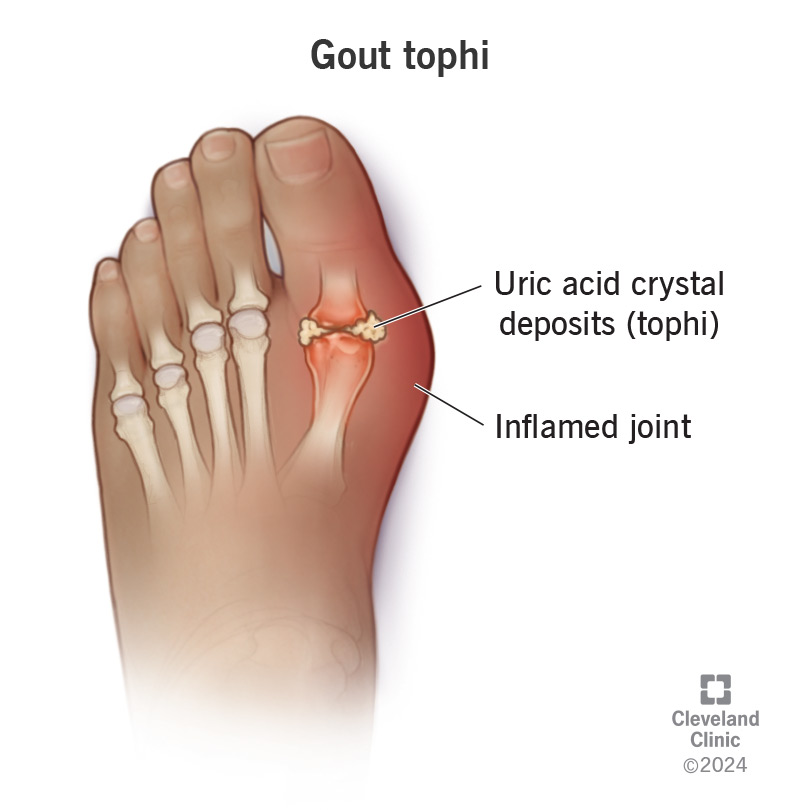When gout goes untreated for many years, or doesn’t respond to treatment, you may develop tophi under your skin. These swollen lumps or growths are uric acid crystal deposits in your tissues. They’re usually painless, but they can grow large and cause complications. You can treat them by taking medications to reduce uric acid in your blood.
Advertisement
Cleveland Clinic is a non-profit academic medical center. Advertising on our site helps support our mission. We do not endorse non-Cleveland Clinic products or services. Policy

Tophi are large uric acid crystal deposits in your tissues. They’re a sign of advanced gout.
Advertisement
Cleveland Clinic is a non-profit academic medical center. Advertising on our site helps support our mission. We do not endorse non-Cleveland Clinic products or services. Policy
When uric acid builds up in your blood (hyperuricemia), it clumps into crystals that settle in your joints, causing the symptoms of gout. These crystals start out very small. But when hyperuricemia and gout become severe, you may develop tophi: large crystal deposits that look like bulbous, swollen growths under your skin. This stage of disease — known as chronic tophaceous gout — takes years to develop.
Tophi typically form in the tissues within and around your joints. These may include:
But tophi can also appear in unconventional places, including your:
Although new uric acid crystals in your joints cause gout symptoms, tophi are typically painless. This may be because they’re old, established crystal deposits, and your body is used to them. However, they can grow large enough to stretch your skin taut, making it feel tender. In some cases, they can break open, releasing a white uric acid discharge. This leaves you with painful open sores that may resist healing.
A tophus (singular of tophi) is a visible or noticeable firm lump under your skin. It’s usually roundish and bulbous. It may be as small as a pea or as large as a tangerine. Sometimes, it has a white head of uric acid discharge working its way to the surface. Sometimes, it will break open and discharge will come out. The white head can help distinguish tophi from similar-looking rheumatoid nodules, which occur with rheumatoid arthritis.
Advertisement
A tophus can weaken and erode the tissues it grows in, including bones. This damage is often irreparable. It can be especially destructive to joints, which rely on soft tissues like cartilage for padding and shock absorption. A tophus can also displace or obstruct a joint, preventing it from moving properly. In rare cases, a tophus may compress a nerve, become infected or interfere with one of your organs.
Excess uric acid in your blood (hyperuricemia) causes uric acid crystals to form. When these crystals settle in your joints, they cause inflammatory arthritis, known as gout. Your immune system sends special cells called macrophages to find and remove the crystals. But when uric acid continues to build, the crystals grow faster than macrophages can remove them, and macrophages build up around them.
After many years, the macrophages start to cluster onto the large crystal, forming a granuloma. This is a secondary reaction from your immune system — an attempt to “wall off” the foreign object from the rest of your body. A tophus (Latin for “stone”) is a large crystal that’s become a granuloma. Tophi happen when hyperuricemia builds up to high levels, which usually means it’s gone untreated.
Although tophi are a late manifestation of gout, rarely, they’ve been reported as a first symptom. In these cases, people didn’t notice or recognize earlier symptoms of gout.
Healthcare providers treat hyperuricemia with medications to reduce uric acid in your blood. This stops gout crystals and tophi from forming. Over time, it can also dissolve the tophi you have. You’ll probably need to stay on these medications for at least six months before the tophi will begin to dissolve. If you have a medical condition that causes hyperuricemia, you may have to take them for the rest of your life.
Medications to reduce uric acid include:
Your provider might also suggest certain lifestyle changes, such as:
Advertisement
If a large tophus is causing complications or seems likely to, your provider might recommend removing it surgically. Surgical removal of a tophus is called a tophectomy. Your surgeon will make incisions over the tophus and either carve or suction it from your tissues. They might also need to remove damaged tissues around it (debridement). If your joint is very damaged, you might need a joint replacement.
There’s no cure for gout, but medications can help keep your uric acid levels low. If you have hyperuricemia, it’s important to treat it to prevent painful symptoms and side effects like tophi.
There’s no shame in depending upon medications to manage a chronic and destructive disease. If your current treatment plan isn’t working, be sure to let your healthcare provider know so they can offer another.
Advertisement
Cleveland Clinic experts can diagnose gout so you can begin treatment to relieve pain. We help alleviate symptoms and prevent future gout flares.

Last reviewed on 04/14/2025.
Learn more about the Health Library and our editorial process.